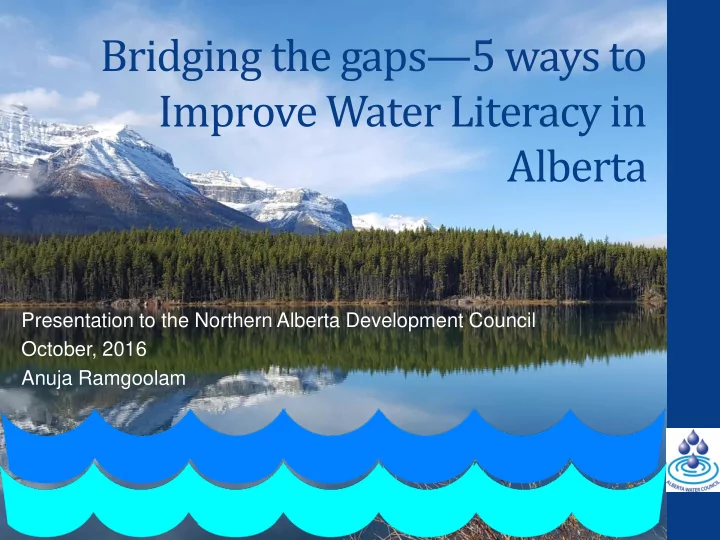

Bridging the gaps—5 ways to Improve Water Literacy in Alberta Presentation to the Northern Alberta Development Council October, 2016 Anuja Ramgoolam
Overview • Alberta Water Council and the project • Methodology and findings • 5 ways for improving water literacy in Alberta • Next steps • Questions
Alberta Water Council • Water for Life partnership • Multi-stakeholder group of 24 members (governments, NGOs, industry) • Consensus decision making process • Policy advice on provincial water management concerns
Water Literacy Project 2013-2014 • Government of • Team completed Alberta Water their work • Project submitted Conversations • Report released to the Alberta Water Council • Team established 2013 2016
Water Literacy Environmental literacy is the capacity to perceive and interpret the relative health of environmental systems and to take appropriate action to maintain, restore or improve the health of those systems. Water literacy is a narrower focus of environmental literacy. Being “water literate” means having an understanding of the significance of water in life, and understanding where water comes from and how to use it sustainably. Alberta Environment and Parks is committed to developing a water literacy strategy that will include actions to promote environmental stewardship among Albertans.
Water Literacy Ladder
Water Literacy Practitioner
Methodology Best practices Inventory Assessment Survey Key Findings
Key Findings: Inventory Survey
Inventory Survey 122 152 65 participants programs organizations
Program Intent Facilitate informed Educate or raise discussions and Provide awareness decision making tools
Type of Organizations
Topics • Watersheds Most • Water Conservation and efficiency Popular • Water cycle • Flood management Least • Groundwater Popular • Surface water • Water allocation Missing • Climate variability and adaptability • Drinking water and wastewater systems
Audiences
Delivery Areas
Challenges Geography Promoting programs Funding
Main Gaps Overall : connections between policy makers and practitioners Drinking water Hydraulic and Wastewater Healthy Aquatic Fracturing Ecosystems No public programs on threats to drinking Few non-industry Many NGOs programs water or how programs exist to but only delivered in wastewater is treated. disseminate larger urban areas. Few Some municipal information on this programs that link programs on these topic. Most targeted by water and aquatic topics are mainly industry in fracking health issues. delivered in larger areas. urban areas.
Key Findings: Northern Alberta
Organizations • Athabasca Watershed Council • Lesser Slave Watershed Council • Mighty Peace Watershed Alliance • ConocoPhillips • Province-wide (e.g., the Government of Alberta, Alberta Council for Environmental Education, First Nations Alberta Technical Services Advisory Group)
Programs and Audiences • conservation and efficiency -mayors, municipal administrators • farm water use -ag producers • lake health monitoring -lake users • water well maintenance -landowners • wetlands -students • watershed -public • water use -industry • water treatment -First Nation technicians • water quality -researchers and policy-makers
Tools social media policies mentorship Water information Literacy webinar booths website presentations
Key Findings: Best Practices
What is a Best Practice? • method or process that represented a successful and/or effective way of achieving a desired program objective • several best practices used by practitioners were documented • organized into program success and program effectiveness
Successful versus Effective Programs Successful Effective • accomplishes • accomplishes desired objectives desired objectives while making use of while making use of time and resources time and resources but may not result in and results in environmental or environmental or behavioural changes behavioural changes
Key Findings: Assessment
Topics and Process • lakes • wetlands Focus groups and • watershed phone interviews • water Pre-test: 20 Albertans • sector water use • drinking water, Actual: 100 Albertans wastewater and groundwater
Northern Alberta n= 20+100 Places included: Fort McMurray (1) Grand Prairie (2) Hythe (1) Mayerthorpe (1) Peace River (1) Plamondon (1)
Lake Management
Wetland Management
Watershed Management Watershed Knowledge—Do you live in a Watershed?
Watershed Management Knowledge about WPACs—Do you know what a WPAC is?
Water Management
Sector Water Use
Drinking Water
Wastewater
Groundwater
General Results • higher levels of awareness and knowledge in some topics than others (e.g., lake management and sector water use) • attitudes on some topics over than others (e.g., wetlands and water management) • Albertans may have the skills to bring about change but these were not being translated into direct actions
5 ways for Improving Water Literacy in Alberta
Increase Collaboration among Water Literacy Practitioners • diversity of programs offered in Alberta • no formal process to facilitate collaboration among practitioners and avoid duplication of efforts • Value in enhancing existing portals or creating a new one
Provide Tools and Knowledge to Assess Program Success and Effectiveness • some practitioners did not measure the success and/or effectiveness of programs—did not know how, or lacked resources • assessed Albertans demonstrated higher levels of awareness and knowledge and lower levels of skills and actions • train the trainer workshops and guidebook and toolbox
Better Align Topics, Audiences, Delivery Areas and Methods • many topics, audiences and delivery areas, but gaps in the concerns addressed, where and to whom • low level of awareness and knowledge among Albertans on basic water topics and the role of Indigenous communities in its management • water 101 campaign—books, information kits, posters, social media
Strengthen Capacity among Water Literacy Practitioner • funding was a common challenge for NGOs—limits program design, delivery and evaluation • new types of funding needed • grants, in-kind support or other types of incentives
Assess Water Literacy among Albertans • many practitioners do not know if the awareness, knowledge, skills, attitudes or actions of their program participants have changed with time • create a baseline of information and assess at periodic intervals • obtain information about what Albertans know about water and what they need to learn more about
What is happening now? • Interim Water Literacy Strategy • Water Literacy Survey Alberta https://extranet.gov.ab.ca/opinio6/s?s=29820
Contact and Resources • Anuja Ramgoolam Project Manager, Alberta Water Council a.ramgoolam@awchome.ca or 780-644-7375 Website: http://awchome.ca/Projects/WaterLiteracy/tabid/199/Default.aspx • Janine Higgins Community Engagement Lead, Alberta Environment and Parks janine.higgins@gov.ab.ca or 587-986-6694 Website: https://extranet.gov.ab.ca/opinio6/s?s=29820
Thank you for listening!
Questions?
Recommend
More recommend